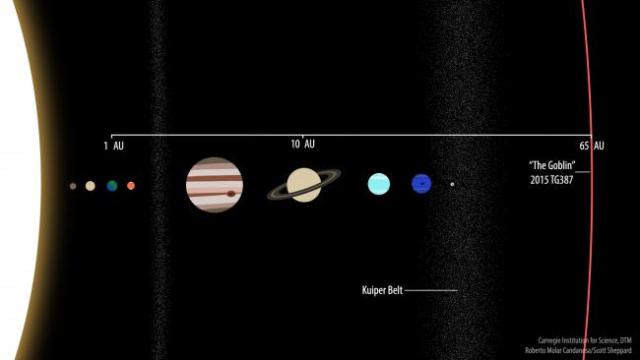Move over, Pluto: There’s a new dwarf planet in our solar system, and its name is the Goblin.
Earlier this week, scientists announced the discovery of an “extremely distant object” that supports the existence of a larger Planet X, also known as Planet Nine. While the new dwarf planet is formally listed as 2015 TG387, discoverers dubbed it “The Goblin” because of its provisional designation “TG” and — no joke — it was first seen around Halloween.
Below, your Goblin-splainer with all the key info about our seasonally-appropriate new friend:
What Is It?
The Goblin is a dwarf planet, which means it orbits around the Sun but does not have a strong enough influence to prevent other planetary bodies from entering its “neighbourhood”. Pluto, which previously held full planet status, was downgraded to a dwarf planet in 2006. Scientists estimate that 2015 TG387 is about 300km in diameter, which makes it relatively small — even for a dwarf planet.
Where Is It?
Scientists found the Goblin about 80 astronomical units (AU) away from the Sun. That’s the equivalent of around 12 billion km — 2.5 times farther away than Pluto. The closest the Goblin comes in its orbit is estimated to be 65 AU, or around 9.7 billion km, while its most distant point is an estimated 2300 AU (around 344 billion km).
So, it’s really, really far away, and researchers say it takes about 40,000 years to complete this orbit.
Two known companion objects — Sedna and 2012 VP113 — exist alongside 2015 TG387 in a so-called Inner Oort Cloud (IOC). An Oort Cloud is an astronomical space that contains icy debris and surrounds our solar system. However, some experts say that an Oort Cloud may not be the most accurate way to depict these discoveries.
Who Found It?
Scott Sheppard, a staff scientist at the Carnegie Institution for Science, Chadwick Trujillo of Northern Arizona University, and David Tholen of the University of Hawaii led the team that discovered 2015 TG387. They first observed the object in October 2015 atop Mauna Kea in Hawaii. Because the Goblin moves so slowly and has such a large orbit, it took three years to gather enough information to determine the its pattern.
OK, So What?
Perhaps the most notable thing about the Goblin is that scientists were lucky to spot it in the first place. There are likely thousands more objects floating around out there in space, but their distance makes them nearly impossible to detect with our current tools. The research team says that 2015 TG387 would be invisible for about 99 per cent of its 40,000-year orbit, which means they were simply in the right place at the right time.
The other exciting piece of the Goblin’s story is that it may point to the existence of Planet X or Planet Nine, a mass thought to be several times larger than Earth. Simulations show that this elusive planet, if it’s real, could be shaping the orbits of small, distant objects such as the 2015 TG387.

Comments